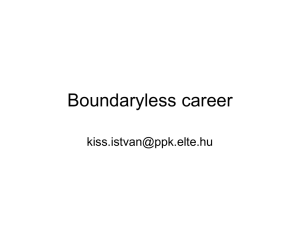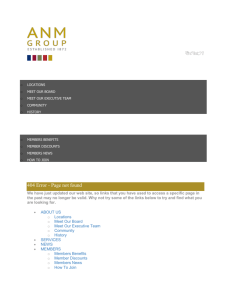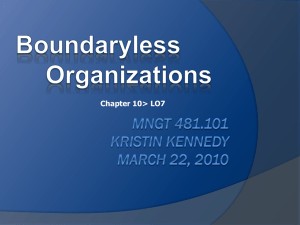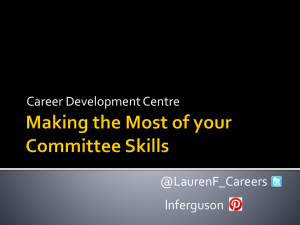The Organizational Career Management and the Career
advertisement
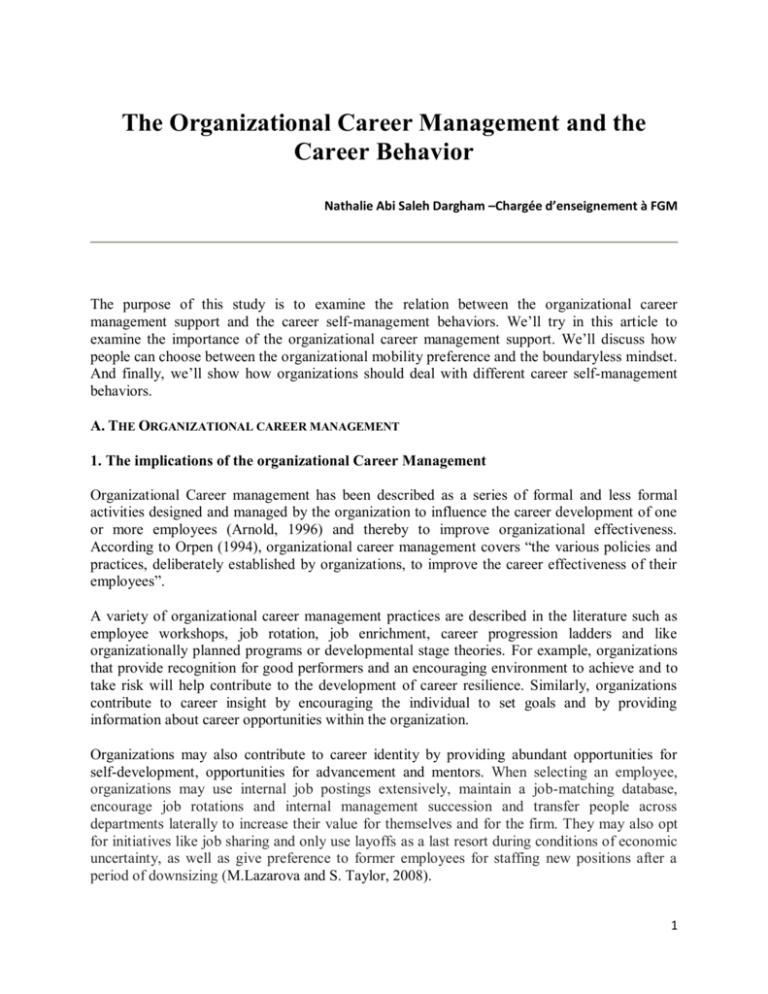
The Organizational Career Management and the Career Behavior Nathalie Abi Saleh Dargham –Chargée d’enseignement à FGM The purpose of this study is to examine the relation between the organizational career management support and the career self-management behaviors. We‟ll try in this article to examine the importance of the organizational career management support. We‟ll discuss how people can choose between the organizational mobility preference and the boundaryless mindset. And finally, we‟ll show how organizations should deal with different career self-management behaviors. A. THE ORGANIZATIONAL CAREER MANAGEMENT 1. The implications of the organizational Career Management Organizational Career management has been described as a series of formal and less formal activities designed and managed by the organization to influence the career development of one or more employees (Arnold, 1996) and thereby to improve organizational effectiveness. According to Orpen (1994), organizational career management covers “the various policies and practices, deliberately established by organizations, to improve the career effectiveness of their employees”. A variety of organizational career management practices are described in the literature such as employee workshops, job rotation, job enrichment, career progression ladders and like organizationally planned programs or developmental stage theories. For example, organizations that provide recognition for good performers and an encouraging environment to achieve and to take risk will help contribute to the development of career resilience. Similarly, organizations contribute to career insight by encouraging the individual to set goals and by providing information about career opportunities within the organization. Organizations may also contribute to career identity by providing abundant opportunities for self-development, opportunities for advancement and mentors. When selecting an employee, organizations may use internal job postings extensively, maintain a job-matching database, encourage job rotations and internal management succession and transfer people across departments laterally to increase their value for themselves and for the firm. They may also opt for initiatives like job sharing and only use layoffs as a last resort during conditions of economic uncertainty, as well as give preference to former employees for staffing new positions after a period of downsizing (M.Lazarova and S. Taylor, 2008). 1 Organizational career management activities are frequently classified as formal activities versus informal activities (Kraimer et al., 2003; Sturges et al., 2000: Sturges et al., 2002). Formal activities include, for instance, training programs, personal development plans, formal career planning. Informal activities include, for example, mentoring and networking opportunities Organizations should customize their HR practices to accommodate different types of employees. In particular, differences in how organizations manage the careers of core and peripheral employees have been recognized by researchers (Chambel & Castanheira, 2007; Fenwick, 2007). According to many career authors, organizational career management supports the development of employee commitment (Sturges et al., 2002). When organizational career management practices meet employees‟ pre-joining expectations (Sturges et al., 2000), this will enhance commitment and other positive outcomes. Career management help can be seen as one form of perceived organizational support. Perceived organizational support has been positively related to job performance and negatively linked to withdrawal behaviors such as absenteeism and turnover (Rhoades & Eisenberger, 2002). Van Dam (2004) found that people who experience more organizational support have a lower employability orientation. Kraimer et al. (2003) studied the relationship between organizational career management and perceived career support. They defined perceived career support as the employee‟s belief that the organization cares about his or her career needs and goals. They found that promotional opportunities and informal organizational career management activities - namely informal career discussions with a boss, participation in challenging job assignments and mentoring relationship(s) with senior colleagues – are positively related to perceived career support. 2. The psychological contract: a framework for understanding the organizational career management outcomes The psychological contract has been defined as an individual‟s beliefs, shaped by the organization, regarding terms of an implicit agreement between the individual and the organization (Rousseau, 1995). As such, a psychological contract emerges when the employee believes that “a promise has been made and a consideration offered in exchange for it, binding the parties to some set of reciprocal obligations”(Rousseau, 1995). Organizational support (Eisenberger et al., 1990), provision of developmental opportunities (Morris et al., 1993), and fairness of treatment (Konovsky & Cropanzo, 1991) are associated with fulfillment of the psychological contract, which in turn is linked to levels of organizational commitment (Robinson & Morrison, 1995). Social exchange theory (e.g., Blau, 1964) suggests that if employees receive support from their employers (in this case in the form of career management help, such as training and career advice), then they will in turn feel obliged to reciprocate (Eisenberger et al., 1990). Reciprocation may take the form of organizational citizenship behaviors (Coyle-Shapiro & Kessler, 2000; Robinson & Morrison, 1995) and job performance (Bunderson, 2001; Johnson & O‟Leary-Kelly, 2003; Turnley & Feldman, 2000). 2 Furthermore, psychological contract breach is strongly associated with individual intention to quit (Robinson & Rousseau, 1994; Robinson, 1996; Tekleab & Taylor, 2003; Turnley & Feldman, 2000) and actual turnover (Robinson & Rousseau, 1994; Robinson, 1996). It has also been linked with negative behaviors at work, such as absenteeism (Johnson & O‟Leary-Kelly, 2003). In addition, if the psychological contract is not fulfilled by provision of career management help, then individuals will feel that the career deal has not been met and as a consequence may look to further their career elsewhere. (Sturges et al., 2005). As a result, they may be more likely to practice the kind of career management behavior aimed at furthering their career outside the organization (Robinson, Kraatz, & Rousseau, 1994; Turnley & Feldman, 1999). Today with frequent organizational changes, such as downsizing, delayering and redundancy, the promise of job security in return for hard work is questioned. Organizations can no longer offer employees careers for life. As a result, careers seem to boundaryless (Arthur & Rousseau, 1996) with the duty placed on individuals to take responsibility for their management (Arnold, 1997). Consequently, the psychological contract that exists between employer and employee has changed to indicate that there is no longer an automatic promise or an expectation of a career for life (Herriot & Pemberton, 1995). So in this new environment, people must be proactive about managing their careers. They should catch appropriate options and opportunities in order to pursue career goals. However, despite the new environmental challenges, many individuals continue to anticipate receiving some kind of career management help from their employers (Sturges et al., 2000). This suggests that the psychological contract will in part reflect careerrelated promises and expectations, which the employee believes that the employer has implicitly communicated (Cavanaugh & Noe, 1999). 3. The negative outcomes of the organizational career management support Career management programs may sometimes generate negative outcomes for organizations and their employees. - - - Instituting a career management program does not necessarily increase the number of opportunities for career advancement in an organization and may actually increase competition among program participants. Also, as people's aspirations rise, fewer opportunities are likely to exist that will satisfy them. Unless an organization takes steps to either meet or adjust such aspirations, perceived career success will decline, and employees may seek opportunities elsewhere to justify the effort they have expended. Organizations may put in place programs that raise aspirations to unrealistic levels. Greater effort in career planning can raise levels of expectations but does not guarantee advancement in an organization. (J.Chew and A.Girardi, 2008). Individuals may not respond positively to the organizational career management program because they may discover that their career plans do not match opportunities available in their current organization. In the absence of information concerning future reality, individuals tend to rate their prospects with an optimistic bias. Those who perceive a match between personal and organizational goals might experience greater satisfaction, but those who perceive a mismatch might experience increasing dissatisfaction. 3 Unless an organization can meet these aspirations for the future, individuals may seek opportunities elsewhere to justify the effort they have expended. Greater certainty about career plans may backfire if individuals discover that their career plans may not match up with available organizational opportunities. This mismatch may lead to lower levels of satisfaction and may ultimately affect commitment and thereby retention. So, when instituting a career management program, managers need to understand how individual planning, organizational career information, and perceived matches between individual and organizational career plans combine to shape and energize employees' career attitudes and behaviors. Ganrose & Portwood (1987) considered that successful career management programs are based on the following assumptions: 1. Individuals involved in career planning will more likely achieve personal aspirations; 2. Clarification of organizational plans and individual opportunities will reduce anxiety and frustration in employees, leading to more positive attitudes toward career progress and organizations. B. THE CAREER SELF-MANAGEMENT BEHAVIORS Career self-management is under the control of the individual and consists of gathering “information and plans for career problem solving and decision-making”. Career selfmanagement contains “the personal efforts made by individuals to advance their own career goals which may or may not coincide with those their organizations have for them” (Orpen, 1994). It involves two main behaviors: one relating to continuous improvement in one‟s current job and the other related to movement; job mobility preparedness”. The choice depends on the type of career strategy that they are pursuing (Sturges and al., 2005). 1. The importance of the career self-management in the current environment In such a turbulent environmental context, the concept of career self-management has become important as the essential nature of careers has shifted. As the nature of organizational life is becoming unpredictable or even chaotic as many have argued, self-management of one‟s career may be the only way to navigate through a turbulent world. Therefore, we can frequently observe that responsibility for career management has shifted to a position where the onus for managing the career rests with the individual who is taking the initiative to set career-related goals and devise appropriate strategies to achieve them. Today, a typical career involves multiple organizations and often dissimilar roles in those organizations. Even employers increasingly expect individuals to take responsibility for managing their own careers. Research revealed that the extent to which people undertake career self-management activities depends on their personality (Guthrie et al., 1998). Crant (2000) introduced the proactive disposition as a construct “that identifies differences among people in the extent to which they take action to influence their environments”. He assumes a relationship between proactive personality and the active management of one‟s career. This assumption was confirmed by the study of Seibert, Kraimer & Crant (2001) revealing a strong positive relationship between proactive personality and career initiative. 4 2. Types of the career self-management orientation Briscoe et al. (2006) distinguished between two different types of career behaviors: o Organizational mobility preference, or the strength of interest in remaining with a single (or multiple) employer(s); o Boundaryless mindset, or one‟s general attitude to working across organizational boundaries. 2.1. Organizational mobility preference or internal boundaryless career management Individuals are driven by their own personal definition of success. They may choose to move across internal functional departments or geographical units of one organization. They decide to accumulate career capital (Inkson & Arthur, 2001) within the same organization through choosing projects that allow them to accumulate diverse knowledge, develop extensive professional networks, and maintain high visibility. M.Lazarova and S. Taylor (2008) proposed a framework that distinguishes between attitudes and behaviors. They recognize the difference between the: o Internal psychological boundaryless careers, or the psychological willingness to be mobile within the boundaries of a single organization in search of increasing individual skill and knowledge sets and assignments that provide the best fit to one‟s current career goals; o Internal enacted boundaryless careers, or the actual movement across internal organizational departments, functions and geographical units. 2.2. Boundaryless mindset Individuals who see the role of organizations as limited to providing them with challenging assignments, professional education, information and other developmental resources (Arthur & Rousseau, 1996; Hall, 2004), decide to cross off one or more boundaries (divisional, organizational, occupational, national, etc.) (Brousseau et al., 1996). Today, careers can no longer be defined within the confines of one company. DeFilippi & Arthur (1996) define boundaryless careers as “…sequences of job opportunities that go beyond the boundaries of a single employment setting”. The new career is also sometimes depicted in terms of a “new deal”, where the psychological contract that exists between employer and employee has changed to reflect the fact that there is no longer a promise of an expectation of as career for life (Herriot & Pemberton, 1995). Traditionally, within the employment relationship, employees exchanged their loyalty and hard work for the promise of job security. However, in this new environment, changes in 5 organizational structure towards more flexible work practices and the decline in job security have altered the psychological contract between employer and employee (Allan, 2002). Today organizations focus on non-core and part-time workers to gain flexibility at lower cost. Current employers emphasize "employability" rather than long-term loyalty in a specific job (Cappelli, 1999; Ko, 2003). The trend these days seems to be geared towards having a „career portfolio‟ (a series of job held by an employee) (Handy, 1995; Hays & Kearney, 2001). According to many authors, commitment to one‟s professional growth (or the adoption of personal career management strategies) has replaced organizational commitment (Bozeman & Perrewe, 2001). Instead of job security, employees now seek job resiliency, opportunities for skill development, and flexibility in order to quickly respond to shifting employer requirements. Employees seem to take greater responsibility for their own professional growth in order to increase their career marketability and welcome the idea of the boundaryless career (Finegan, 2000). According to M.Lazarova and S. Taylor (2008), boundaryless careers encompass six different meanings: 1. They involve movement across the boundaries of several employers; 2. They draw validation and marketability from outside one‟s present employer; 3. They are sustained by external networks and information; 4. They break traditional organizational assumptions about hierarchy and career advancement; 5. They involve rejecting existing career opportunities for personal or family reasons; 6. They are based on the interpretations of the career actor who may perceive a boundaryless future regardless of structural constraints (Arthur &Rousseau, 1996: 6). In the table below, we can clearly examine the differences between the traditional career and the new career. 6 Sullivan and Arthur (2006) suggest that boundaryless careers are characterized by two basic types of mobility, each measured on a continuum: o Physical mobility (the transition across boundaries) o Psychological mobility (receptivity and perceived capacity to cross boundaries). Here also, M.Lazarova and S. Taylor (2008) proposed a framework that distinguishes between attitudes and behaviors. They recognize the difference between the: o External psychological boundaryless careers, or the psychological willingness to make changes and a readiness to move to a different employer in order to increase the returns on one‟s human capital; o External enacted boundaryless careers, or the actual mobility across different firms. 3. The barriers to career self-management We‟ll present here below some factors that restrain any kind of voluntary career exploration: 1. Person-centered characteristics (e.g., gender1, age, specific skills, and traits) (Powell, 2000). a. Individuals who belong to a certain low working class don‟t have access to opportunities, and consequently they are less likely to have access to the career development field. b. Individuals who lack the confidence, and/or the skills, or they may simply not be aware of various opportunities in their environment are less likely to advance in their career path. c. Career indecision presents another serious barrier to successful career exploration, one that may constantly affect the way in which individuals explore and thus lead to serious maladaptive career outcomes (Kelly & Lee, 2002). d. Women are often subject to biased evaluation and treatment. Working women experience more home-career role conflicts and overload compared to men. Women have traditionally received less on-the-job training and less critical constructive feedback from supervisors (Corcoran and Duncan, 1979). 2. Macroeconomic and social characteristics a. Sometimes the individuals may be hurdled by strong societal norms and tradition (Blustein, 2001a). b. In some regions where the economic conditions are hard, career exploration may only be geared to finding any job at all, rather than allowing options and choices from which to choose the best fit. c. The sociocultural characteristics may also restrain career exploration options. 1 For example, the class ceiling effect for women is evident in some corporate practices and policies (e.g., training, career development, promotion, and compensation), which is often identified as a major barrier preventing women from making it to the top (Oakley, 2000). 7 d. Career decisions are strongly influenced by the relationship structure to which individuals belong. Relational influences that are part of individuals' contextual milieu serve not only as sources of social support but also as barriers to healthy career exploration (Blustein, 2001b). For example, parents may actually constrain the choices of individuals and influence their career plans in a way that limits selfdetermination (Blustein, 2001b). 3. The organizational characteristics: The work environments may also restrain career exploration options. 4. The chance: Chance events can be described as "unplanned, accidental or otherwise situational, unpredictable, events or encounters that have an impact on career development and behavior" (Rojewski, 1999). For many individuals, career exploration will be the result of both planning and chance events, as emphasized by the planned happenstance theory (Mitchell et al., 1999). C. The organizational career management support and the career self-management behavior Unfortunately, research topics are not clear on how organizational career management and selfcareer management are connected (Gunz & Jalland, 1996). Many authors have criticized the strict demarcations between individual and organizational careers (Cohen & Mallon, 1999). As we saw above, some individuals construct their careers within organizations and their career development is strongly influenced by existing career management systems (M.Lazarova and S. Taylor, 2008) and some others decide to develop their careers in multiple organizations. Through their HR practices, organizations play an important role in shaping individual careers. Organizational career processes affect career self-processes (and vice versa) (Gunz, 1989; Sturges et al., 2002). The organization influences the individual through sending expectations about appropriate role behavior, defined as the „„recurring actions of an individual, appropriately interrelated with the repetitive activities of others so as to yield a predictable outcome‟‟ (Katz & Kahn, 1978: 189). Thus, role expectations sent by the organization ensure fairly predictable patterns of individual behavior. We agree with Sturges et al. (2002) who argue that organizational career management and self career management are not mutually exclusive. According to these authors, careers are best managed by a reciprocal partnership between individuals and organizations that creates a virtuous cycle through which employees are both committed to the organization and ready to manage their own careers in ways that benefit both themselves and their employers. All in all, firms are best advised to approach career management as a negotiated process between individuals and organizations (Schein, 1996). Boundaryless careers should be considered carefully and managed strategically. 8 1. The organizational management of internal psychological and enacted boundaryless careers Individuals who choose the internal enacted boundaryless careers, struggle to know influential people, seek continuously career advice, and draw attention to their achievements. They send out a signal that they are committed both to the organization and to success. And in return, they may expect their employer to reciprocate with career management help. Thus internally oriented career self-management behavior is likely to be associated with the experience of organizational career management help. Organizations should create the favorable environment that facilitates the internal psychological boundaryless careers and enhances the internal enacted boundaryless careers. When individuals move around the organization, they are more likely to form new relationships with colleagues across departments. Such new relationships will be a natural outcome of intra-organizational transfers. Organizational structural social capital will be increased as there will be more linkages between employees and the configuration of these linkages will be improved. The increased social cohesiveness resulting from both types of internal boundaryless careers will increase generalized trust and associability, thus enhancing relational social capital. The trust and associability the person must develop in one unit in order to perform his/her job will need to be developed again in the new unit or function, while maintaining at least some links with colleagues from the organizational unit in which he was previously working, leading to an additional increase of relational social capital (Kostova & Roth, 2003). Finally, increased connectivity and/or employee transfers across departments will result in dispersion and reinforcement of similar ideas across the organization. HR practices such as Organizational support, provision of developmental opportunities and fairness of treatment are more likely to enhance the internal enacted and psychological boundaryless. Organizational support revealed in the form of training, compensation and reward can lead to reduced turnover, absenteeism, better quality work, and better financial performance. The big challenge for HR practitioners is to design holistic systems that influence commitment and promote positive work experiences. It‟s indispensable to put into practice “bundles” of human resource management practices (Macduffie, 1995; Youndt, Snell, Dean & Lepak, 1996) to enable the internal psychological and enacted boundaryless careers and hence positively influence organizational performance (Huselid, 1995). Selective staffing, competitive and equitable compensation, recognition, and comprehensive training and development activities (career development, challenging opportunities) (Macduffie, 1995; Snell & Dean, 1992; Youndt et al, 1996) will enhance employee retention. 2. The organizational management of external psychological and enacted boundaryless careers 9 Raider and Burt (1996) point out that employee departure can have undesirable consequences when employees take away with them exclusionary social capital such as client relations, or if they join or establish an organization operating in direct competition with the organization they left. On a similar note, Griffith and Harvey (2004) comment that organizations often acquire professional networks and expertise by hiring away from competitors but do not pay attention to networks and expertise they lose to competitors. External enacted boundaryless careers may lead to „„withered and estranged‟‟ organizational social capital that can thwart the incentives to cooperate and innovate (Tempest et al., 2004: 1524). A widely shared expectation of short-term employment tenure can gradually destroy trust, loyalty and mutual commitment. Organizations through different HR practices (Recruitment systems, Training and Development plans, Performance Management practices and Pay structures), should minimize these undesirable external psychological boundaryless careers and external enacted boundaryless careers. But, sometimes in certain contexts, organizations should promote external psychological or external enacted boundaryless careers (e.g., under conditions of economic instability that require organizations to maintain maximum flexibility). Thus the big issue is to keep encouraging optimal rates of external enacted boundaryless careers to maintain both continuous flow of new ideas and stability that allows for the most efficient transfer of these new ideas. In this case, to relieve the negative impact of employee departures associated with external enacted boundaryless careers, organizations can attempt to manage actively relationships with former employees, similar to the way McKinsey & Co. maintains connections with its „„alumni‟‟, many of whom work for potential clients. Some ideas include sponsoring social events for former employees or mailing company newsletters. Such relationship building efforts may help firms retain the social capital they share with former employees (Somaya, Williamson, & Lorinkova, 2007). Another possibility is maintaining an alliance with client or partner companies in which a firm‟s departing employees are given preference for new job openings in other alliance firms. So, the external enacted boundaryless may have a positive effect on the organization through increasing inter-firm coordination, if former employees help bridge the networks between two cooperating firms (Raider & Burt, 1996). But this is only useful if the organizations between which employees have transitioned are in the same business or are cooperating (or a realistic potential for cooperation exists). Conclusion The purpose of this study was to examine the relationship between the organizational career management support and the practice of career self-management behaviors. Organizations can contribute to career identity by providing abundant opportunities for selfdevelopment, opportunities for advancement, and mentors. This type of organizational support may enhance the development of employee commitment but it may also generate negative outcomes for organizations and their employees. This is why successful career management programs should involve the individuals in career planning and clarify the organizational plans to individuals to reduce their anxiety and frustration. 10 Nowadays, the concept of career self-management has become important as the essential nature of careers has shifted. Some people construct their careers within organizations and their career development is strongly influenced by existing career management systems and some others decide to develop their careers in multiple organizations. Today, a typical career involves multiple organizations and often dissimilar roles in those organizations. Even employers increasingly expect individuals to take responsibility for managing their own careers (Bridges, 1995). However, despite the new environmental challenges, many individuals continue to anticipate receiving some kind of career management help from their employers. Through their HR practices, organizations play an important role in shaping individual careers. Organizational career processes affect career self-processes (and vice versa). The organization influences the individual through sending expectations about appropriate role behavior. The organizational challenge is finding the right balance of internal and external boundaryless careers. References Allan, P. (2002). The contingent workforce: challenges and new directions. American Business Review, 20(12), 103-11. Arnold, J. (1996). „The psychological contract: A concept in need of closer scrutiny?‟ European Journal of Work and Organizational Psychology, 5(4), pp. 511-20. Arnold, J. (1997). Managing careers into the 21st century. London: Paul Chapman. Arthur, M., & Rousseau, D. (1996). The boundaryless career. Oxford: Oxford University Press. Blau, P. (1964). Exchange and power in social life. New York: John Wiley. Blustein, D. L. (2001a). Extending the reach of vocational psychology; Toward an inclusive and integrative psychology of working. Journal of Vocational Behavior, 59, 171-182. Blustein, D. L. (2001b). The interface of work and relationships: Critical knowledge for 21st century psychology. The Counseling Psychologist, 29, 179-192. Bozeman, D.B., & Perrewe, P.L. (2001). The effect of item content overlap on Organizational Commitment Questionnaire - Turnover Cognitions Relationships. Journal of Applied Psychology, 86(1), 16-25. Briscoe, J., Hall, T., & Frautschy DeMuth, R. L. (2006). Protean and boundaryless careers: An empirical exploration. Journal of Vocational Behavior, 69, 30–47. Brousseau, K. R., Driver, M. J., Eneroth, K.,&Larsson, R. (1996). Career pandemonium: Realigning organizations and individuals. The Academy of Management Executive, 10, 52–66. Bunderson, S. (2001). How work ideologies shape the psychological contracts of professional employees: doctors‟ responses to perceive breach. Journal of Organizational Behavior, 22, 717– 741. 11 Cappelli, P. (1999). The New Deal at Work: Managing the Market-Driven Workforce. Boston: Harvard Bus. Sch. Press. Cavanaugh, M., & Noe, R. (1999). Antecedents and consequences of relational components of the new psychological contract. Journal of Organizational Behavior, 20, 323–340. Chambel, M. J., & Castanheira, F. (2007). They don‟t want to be temporaries: Similarities between temps and core workers. Journal of Organizational Behavior, 28, 943–959. Chew J. and Girardi A., Is Career Management the panacea to retaining vital staff?, International Journal of Management and Marketing Research, 1, 83-98. Cohen, L., & Mallon, M. (1999). The transition from organisational employment to portfolio working: Perceptions of „boundarylessness‟. Work, Employment and Society, 13, 329–352. Coyle-Shapiro, J., & Kessler, I. (2000). Consequences of the psychological contract for the employment relationship: a large-scale survey. Journal of Management Studies, 37(7), 903–930. Crant, J.M. (2000). Proactive behavior in organizations. Journal of Management, 26 (3), 435-462. DeFillippi, R., & Arthur, M. (1996). Boundaryless contexts and careers: a competency-based perspective. In M. Arthur & D. Rousseau (Eds.), The boundaryless career: A new employment principle for a new organizational era (pp. 116-131). New York: Oxford University Press. Eisenberger, R., Fasolo, P., & Davis-LaMastro, V. (1990). Perceived organizational support and employee diligence, commitment, and innovation. Journal of Applied Psychology, 75(1), 51-59. Fenwick, T. (2007). Knowledge workers in the in-between: Network identities. Journal of Organizational Change Management, 20, 509–524. Finegan, J.E. (2000). The impact of person and organizational values on organizational commitment. Journal of Occupational and Organizational Psychology, 73 (2), 149-154. Gunz, H. P., & Jalland, R. M. (1996). Managerial careers and business strategies. Academy of Management Review, 21, 718–756. Guthrie, J.P., Coate, C.J., & Schwoerer, C.E. (1998). Career management strategies: the role of personality. Journal of Managerial Psychology, 13 (5/6), 371-386. Hall, D.T. (2002). Careers in and out of organizations. Thousand Oaks, CA: Sage Publications. Handy, C. (1995). Trust and the virtual organization. Harvard Business Review, 73(3), 40-50. Hays, S.W., & Kearney, R.C. (2001). Anticipated changes in human resource management: views from the field. Public Administration Review, 61(5), 585-592. Herriot, P., & Pemberton, C. (1995). New deals: the revolution in managerial careers. Chichester: John Wiley. Herriot, P., & Pemberton, C. (1996). Contracting careers. Human Relations, 49, 757–790. Herriot, P., & Pemberton, C. (1997). Facilitating new deals. Human Resource Management Journal, 7(1), 45–56. Inkson, K., & Arthur,M. B. (2001). How to be a successful career capitalist. Organizational Dynamics, 30, 48–61. Johnson, J., & O‟Leary-Kelly, A. (2003). The effects of psychological contract breach and organizational cynicism: not all social exchange violations are created equal. Journal of Organizational Behavior, 24, 627–647 Ko, J.J.R. (2003). Contingent and internal employment systems: substitutes or complements. Journal of Labor Research, 24(3), 473-491. 12 Konovsky, M., & Cropanzo, R. (1991). Perceived fairness of employee drug testing as a predictor of employee attitudes and job performance. Journal of Applied Psychology, 76, 698–707. Kraimer, M.L., Seibert, S.E., Wayne, S.J. & Liden, R.C. (2003). Examining employee performance and turnover intentions from a career perspective. Paper presented at the Annual meeting of the Academy of Management, Seattle. Lazarova M. and Taylor S. (2009), Boundaryless careers, social capital and knowledge management: implications for organizational performance, Journal of Organizational Behavior, 30, 119-139. Mitchell, K. E., Levin, A. S., & Krumboltz, J. D. (1999). Planned happenstance: Constructing unexpected career opportunities. Journal of Counseling & Development, 77, 115-125. Morris, T., Lydka, H., & Fenton-O‟Creevy, M. (1993). Can commitment be managed? A longitudinal analysis of employee commitment and human resource policies. Human Resource Management Journal, 3(3), 21–39. Orpen, C. (1994). The effects of organizational and individual career management on career success. International Journal of Manpower, 15 (1), 27-37. Powell, G. (2000). Women and men in management. Newbury Park, CA: Sage. Rhoades, L., Eisenberger, R., & Armeli, S. (2001). Affective commitment to the organization: the contribution of perceived organizational support. Journal of Applied Psychology, 87(5), 825-836. Robinson, S. (1996). Trust and breach of the psychological contract. Administrative Science Quarterly, 41, 574–599 Robinson, S., & Morrison, E. (1995). Psychological contracts and OCB: the effect of unfulfilled obligations on civic virtue behavior. Journal of Organizational Behavior, 16, 289–298. Robinson, S., & Rousseau, D. (1994). Violating the psychological contract: not the exception but the norm. Journal of Organizational Behavior, 15, 245–259. Robinson, S., Kraatz, M., & Rousseau, D. (1994). Changing obligations and the psychological contract: a longitudinal study. Academy of Management Journal, 37(1), 137–152. Rojewski, J. W. (1999). The role of chance in the career development of individuals with learning disabilities. Learning Disability Quarterly, 22, 267-278. Rousseau, D. (1995). Psychological contracts in organizations: Understanding written and unwritten agreements. Newbury Park, CA: Sage. Seibert, S.E., Kraimer, M.L. & Crant, J.M. (2001). What do pro-active people do? A longitudinal model linking proactive personality and career success. Personnel Psychology, 54, 845-874. Sturges, J., Guest, D., & Mackenzie Davey, K. (2000). Who‟s in charge? Graduates‟ attitudes to and experiences of career management and their relationship with organizational commitment. European Journal of Work and Organizational Psychology, 9 (3), 351-370. Sturges, J., Guest, D., Conway, N., & Mackenzie Davey, K. (2002). A longitudinal study of the relationship between career management and organizational commitment among graduates in the first ten years at work. Journal of Organizational Behavior, 23, 731-748. Sturges, J., Guest, D., Conway, N., & Mackenzie Davey, K. (2002). A longitudinal study of the relationship between career management and organizational commitment among graduates in the first ten years at work. Journal of Organizational Behavior, 23, 731Sullivan, S.E. (1999). The changing nature of careers: a review and research agenda. Journal of Management, 25 (3), 457-484. 13 Tekleab, A., & Taylor, S. (2003). Aren‟t there two parties in an employment relationship? Antecedents and consequences of organization-employee agreement on contract obligations and violations. Journal of Organizational Behavior, 24, 585–608. Turnley, W., & Feldman, D. (1999). The impact of psychological contract violations on exit, voice, loyalty and neglect. Human Relations, 52(7), 895–922. Turnley, W., & Feldman, D. (2000). Re-examining the effects of psychological contract violations: unmet expectations and job dissatisfaction as mediators. Journal of Organizational Behavior, 21, 25–42. Van Dam, K. (2004). Antecedents and consequences of employability orientation. European Journal of Work and Organizational Psychology, 13 (1), 29-52. 14


